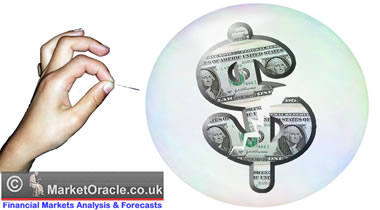U.S. Dollar, the Mother of all Mathemagical Derivatives
Currencies / US Dollar Aug 23, 2011 - 04:26 AM GMTBy: Aftab_Singh
 We all think we know the story of the recent ‘bubble in credit’. As the explanation goes; Americans took on too much debt, those debts were ‘packaged up’ into complex financial instruments, those instruments were then bought, sold and ‘re-packaged’ by people who didn’t even understand them, blah blah blah… Even with this cursory and boringly consensual view of recent history, at least people have figured out that they shouldn’t blindly trust the mathemagicians… or have they? Here I ask; what about the king of all derivatives; the one that deviously subsumes all others? Indeed, what about the derivative that even derivative traders assume to be axiomatically fundamental and distinctly not derived?
We all think we know the story of the recent ‘bubble in credit’. As the explanation goes; Americans took on too much debt, those debts were ‘packaged up’ into complex financial instruments, those instruments were then bought, sold and ‘re-packaged’ by people who didn’t even understand them, blah blah blah… Even with this cursory and boringly consensual view of recent history, at least people have figured out that they shouldn’t blindly trust the mathemagicians… or have they? Here I ask; what about the king of all derivatives; the one that deviously subsumes all others? Indeed, what about the derivative that even derivative traders assume to be axiomatically fundamental and distinctly not derived?
 The sixty-four thousand dollar …ahem… question: What is a dollar?
The sixty-four thousand dollar …ahem… question: What is a dollar?
I didn’t do this intentionally, but I have to say that the phrase in the subtitle above couldn’t be more appropriate for this article. There is some kind of stupid definitional circularity in it; for what kind of question is; ‘What is a dollar?’ for a supposedly ‘sixty-four thousand dollar question’? Sixty-four thousand of what, precisely!? This summarizes a great folly of recent and present years; the assumption that it’s somehow ok to flagrantly assume the rudiments because the rest (which is premised on said rudiments) will ‘just work out’. At the peak of the bubble in credit production, the attitude towards financial wizardry had become; ‘never you mind how, it just is, ok?’ or ‘who cares? It works! It’s practical‘ or even ‘One’s got to have faith in something, right?’
The ensuing collapse in virtually all asset prices, but particularly in bank stocks, is probably an important milestone in the wind down of financial wizardry. People have started to realize that they shouldn’t appeal to the supposed authority of inapplicable mathematical posturing. We’ve seen all the usual lagging indicators to signal this; regulators are hassling the finance guys with record (and increasing) vigor, the masses have rediscovered that they hate the bankers and, of course, politicians have made full use of that part of their oratory arsenal. But, alas, the mother of all mathemagical derivatives remains enshrined with the faith of the people.
As we all know, the dollar is not a promise for anything as such. It is an irredeemable claim upon a tiny slice of a portfolio of assets maintained by a pseudo-democratically elected committee of bureaucrats. There is no promise that the portfolio of assets will remain the same or similar, and there is no promise that the ‘tiny slice’ will remain precisely that tiny. The assets may well diminish in quality, and the tiny slice may well become progressively tinier. Indeed, the assets have diminished in quality and these tiny slices have become even tinier. It is professed that the committee does ‘whatever it takes’ to adjust these irredeemable claims (that derive their values from the portfolio of assets backing them) to imply that the prices of completely unrelated consumer goods increase by a specific percentage each year in aggregate. Oh, and by the way the baskets used to judge the increases in consumer goods prices happen to be decided by a different, but not-too-unfriendly committee of bureaucrats. However, even with this objective relating to consumer prices, there is no promise with respect to this attribute as such.
The dollar, then, is the never-you-mind-sir-we-know-what-we’re-doing derivative; the mother of all dodgy derivatives. Moreover, it is the mother of all dodgy derivatives in a literal sense because the vast majority of derivatives are unthinkingly denominated in it; and it is the mother of all dodgy derivatives in a metaphorical sense because even the high authorities of the financial wizards bow down to it.
The Continuation of Supposedly Exposed Follies:
There we have it, the follies of the recent past are still in force. After all, one of the reasons for the bubble in credit was that even people who didn’t understand the financial instruments in question dealt with them heavily (and perhaps exclusively in some cases). And of course, today virtually the entire world deals with an instrument that is only shallowly understood even by people who specialize in understanding it (which perhaps includes us)!
Alas, just as people used to be bribed into forestalling comprehension with the derivatives of the late 2000s, globally, people are bribed into ignoring monetary matters because ‘the dollar works’. Incidentally, this is one of the rebuttals used by proponents of central planning in the monetary sphere. Quite preposterously, they say; ‘you use it, it works!’.
Huh? So, the long gold trade isn’t an ode to barbarism but a position against the most utterly confounding derivative in the world?
Now that the gold bull market is very well-developed and that it is no longer considered a ‘crazy guy asset’ in financial circles, it should be clear that a way to trade against the major fiat currencies of the world is by the ownership of gold. In an adapted sense, the words of Carroll Quigley in Tragedy & Hope: A History of the World in Our Time remain true:
In each country the supply of money took the form of an inverted pyramid or cone balanced on its point. In the point was a supply of gold and its equivalent certificates; on the intermediate levels was a much larger supply of notes; and at the top, with an open and expandable upper surface, was an even greater supply of deposits. Each level used the levels below it as its reserves, and, since these lower levels had smaller quantities of money, they were “sounder.” A holder of claims on the middle or upper level could increase his confidence in his claims on wealth by reducing them to a lower level, although, of course, if everyone, or any considerable number of persons, tried to do this at the same time the volume of reserves would be totally inadequate.
The increasing interest in gold, which is manifest in a higher dollar price of gold (and currently a higher dollar price of US treasury bonds), represents an abandonment of irredeemable claims upon assets (gold and treasury bonds) for the very assets themselves. It is a way of the market embracing the ‘sounder’ things and abandoning the ‘claims’. Formerly this was done by redemption. Since the fiat currencies of the world are now irredeemable, the mechanism of today is exchange.
So, the long gold trade is hardly (as has been said over the years), a regression into barbarism but rather a fairly complex and convoluted trade against the most utterly confounding derivative in the world. In fact, that some people still regard it as an ode to barbarism is a testament to their trust in things they don’t understand!
[Of course, this is not to say that all owners of gold understand the complexity of their trade. Indeed, as bull markets progress, the reasons often reduce in size and complexity so as to appeal to potential investors' willingness to embrace a price trend (and go with what works). That being said, it should be clear that many people in the long gold trade (and in particular those who were in it early) are hardly doing something brutish with a 'barbarous relic', but in fact something that is quite opposite to that.]
Contradicting Reality with One’s Personal Prejudices:
I should make clear that there’s nothing wrong – as such – with a currency that depreciates against a basket of consumer goods a specific annualized rate. Personally, I find it a little strange that anyone would really want such a currency, but nevertheless there’s nothing bad as such with that type of currency. The problem only arises when it is forced upon people. There are many arguments for these a CPI-hugging currencies, and great intellectual acrobatics have been used over the years to justify them:
However unlovely a non-CPI-hugging currency seems to any particular individual; one cannot escape the fact that people want what they want. Indeed, whatever the justifications held by any particular individual, it cannot trump the truth that each individual owns himself and his stuff. Therefore, a violently implemented centrally planned monetary system cannot be rationally justified. If people really did want a CPI-hugging currency, they would demand it and entrepreneurs would supply it! It is nothing less that completely moronic to think that a CPI-hugging money is somehow inherently desirable.
Conclusion:
The unraveling of an enormous scheme based on appealing to supposedly higher authorities is yet to come. A means of positioning for this is to be long gold. Gold is often portrayed as some kind of ‘lower’ thing; in fact, the ownership of gold is a highly complex play against the most convoluted and opaque derivative in the world: the dollar.
Aftab Singh is an independent analyst. He writes about markets & political economy at http://greshams-law.com .
© 2011 Copyright Aftab Singh - All Rights Reserved
Disclaimer: The above is a matter of opinion provided for general information purposes only and is not intended as investment advice. Information and analysis above are derived from sources and utilising methods believed to be reliable, but we cannot accept responsibility for any losses you may incur as a result of this analysis. Individuals should consult with their personal financial advisors.
© 2005-2022 http://www.MarketOracle.co.uk - The Market Oracle is a FREE Daily Financial Markets Analysis & Forecasting online publication.




